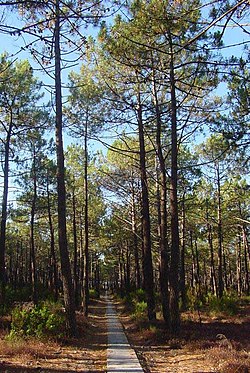Landes forest
| Landes forest French: La forêt des Landes Occitan: las Lanas de Gasconha |
|
|---|---|

A stand of Pinus pinaster
|
|
| Geography | |
| Location | Landes, Gironde, and Lot-et-Garonne départements, Aquitaine, France |
| Coordinates | 44°10′48″N 0°34′56″W / 44.18°N 0.5822°WCoordinates: 44°10′48″N 0°34′56″W / 44.18°N 0.5822°W |
| Elevation | 0 metres (0 ft) |
| Area | 10,000 km2 (3,900 sq mi) |
| Status | Private |
| Established | June 19, 1857 (19 june 1857 law) |
| Governing body | Multiple private |
| Ecology | |
| WWF Classification | Atlantic mixed forests |
| Disturbance | Wildfire, Windthrow, Logging |
| Dominant tree species | Maritime pine |
The Landes forest (La forêt des Landes in French) or the Landes of Gascony (las Lanas de Gasconha in the Gascon language), in the historic Gascony natural region of southwestern France now known as Aquitaine, is the largest maritime-pine forest in Europe. The French word, landes and Gascon lanas, mean 'moors' or 'heaths'.
The forest (also known as the 'moors of Gascony', and formerly, the 'moors of Bordeaux') covers a large portion of Landes and Gironde, two of the departments of France; it also spills over into parts of the Lot-et-Garonne department. The sources of several rivers can be found in this region, including the sources of the Leyre, the Boudigau, the Ciron, and the Gat Mort. The largest towns within the forest are Arcachon, Dax, and Mont-de-Marsan.
The forest is composed mostly of maritime pine, Pinus pinaster. Unlike many other European forests, the Landes forest is almost entirely created and managed by man for industrial purposes. This massive pine plantation was started in the 18th century in the Pays de Buch area of Gironde, to halt erosion and cleanse the soil.
Most of the region now occupied by the Landes forest was swampy land that was sparsely inhabited until the 19th century, when the 19 June 1857 law ended traditional pastoralism and led to wide scale reforestation, in order to rehabilitate the landscape and provide for regional economic development. Prior to this period, the people of the Landes used stilt-walking to move from place to place in the wet terrain. Since the 1970s, parts of the forest have given way to intensive agriculture (in particular, grain farming.)
...
Wikipedia

